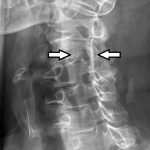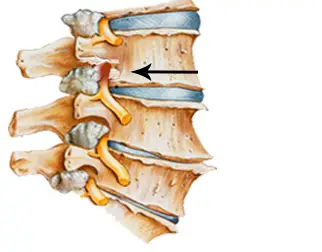La foraminal stenosis is a medical condition that can lead to sick leave. If you suffer from a foraminal stenosis, it's important to know the facts and educate yourself about your options. In this article, we are going to talk about the foraminal stenosis and the impact it may have on your ability to work. We will also see if the foraminal stenosis whether or not it is recognized as an occupational disease. Keep reading to find out more!
Spine Anatomy
The anatomy of the spine is perfectly designed to perform different functions. All elements of the spine and vertebrae serve, for example, to protect the spinal cord, which is responsible for communication with the brain, mobility and bodily sensations.
It is the central pillar of the whole body, which supports the trunk and allows us to perform all the movements of the head, arms and legs.
The spine is made up of 33 vertebrae stacked on top of each other which, along with muscles, perform the functions of support, balance and movement. They are separated into five sections:
- La cervical spine (C1-C7);
- The thoracic spine (T1-T12);
- The lumbar spine (L1 to L5);
- The sacred column (S1 to S5);
- and the coccygeal column.
The spinal cord runs through the vertebral column, protected by the vertebrae. The bones of the spine are connected by joints called facets, which allow slight movement between the vertebrae.
Short definition of foraminal stenosis (cervical, lumbar)
La foraminal stenosis is a condition that results in narrowing of the foramina. These are the small openings between the vertebrae through which the spinal nerves pass. When these openings narrow, they can put pressure on nerves and cause pain, numbness, and tingling in the extremities.
Foramen stenosis can occur in different parts of the spine, including the neck (cervical foramen stenosis), thoracic spine (dorsal foramen stenosis), and lower back (lumbar foramen stenosis).
To know everything about the foraminal stenosis, see the following article.
Causes of foraminal stenosis
The following causes can lead to a foraminal stenosis of the spine:
- Spinal injuries accompanied by damage to the ligamentous apparatus;
- Healing of traumatic lesions at the foraminal openings;
- Pathological mobility of the vertebrae leading to narrowing of the vertebral foramina and a change in the shape of the spinal canal;
- Spondylarthrosis;
- Destruction of intervertebral joints;
- Ankylosing spondylitis ;
- Compression fractures of the vertebral bodies;
- Fractures of the spinous processes of the vertebral bodies;
- Intervertebral hernia;
- Extension of the annulus fibrosus;
- Postural disorders associated with spinal deformity.
Even in the absence of the aforementioned diseases, a foraminal stenosis can develop in patients of different age groups. Following medical observations, specialists were able to determine the risk factors for this disease. Among the predisposing factors are:
- Overweight ;
- Obesity;
- A sedentary lifestyle, which leads to dystrophy of the back muscles and deformation of the muscular skeleton;
- All types of postural disorders (kyphosis, lordosis, scoliosis);
- Damage to the position of the foot when walking and running;
- Foot deformities;
- Abnormalities of the leg bones;
- Pathological changes in the femoral neck;
- Intense physical activity;
- Poorly chosen mattresses and pillows.
Weight control, timely medical visits and the elimination of potential risk factors help prevent the development of a dangerous and quite painful process in the spine.
Symptoms of foraminal stenosis
The disease develops slowly. For years, a person does not suspect the appearance of degenerative changes in the vertebrae. The first characteristic symptom of foraminal stenosis spinal is pain.
With spinal stenosis in the cervical vertebrae, for example, patients notice pain in the neck that radiates to the shoulder at the back of the head. When the thoracic vertebrae are involved, the pain manifests in the torso, upper limbs and shoulder blades.
Typical symptoms of foraminal stenosis lumbar:
- Pain in the lumbar region, which is accentuated with walking;
- Radiation of pain to front and back of thigh and leg;
- Numbness in the legs;
- Decreased sensitivity below the area of stenosis;
- Impairment of the processes of urination and defecation;
- Erectile dysfunction, potency problems.
The pains increase after prolonged physical exertion and can practically disappear in a certain position of the body.
The forms of foraminal stenosis which are accompanied by a disturbance of the functions of internal organs in connection with a lesion of their innervation are especially dangerous.
Foraminal stenosis: Limitations at work
Neck or lumbar pain caused by foraminal stenosis may vary in intensity and duration depending on the location and severity of the condition. In some cases, the pain may be mild and last only a short time.
However, in other cases, the pain may be more intense and last longer. The foraminal stenosis may also cause difficulty performing physical tasks such as static postures, heavy lifting, or other activities that require physical exertion, which may interfere with work.
If you suffer from a foraminal stenosis, you may need to take time off work to recover from this condition.
Foraminal stenosis, recognized as an occupational disease?
In some cases, the foraminal stenosis can be recognized as an occupational disease. This means that you may be entitled to certain benefits if your work caused or worsened your condition.
At the cervical level, there is currently no recognition for foraminal stenosis.
If it affects the lumbar levels, the foraminal stenosis must be associated with a herniated disc with concordant root damage (Of type sciatica ou cruralgia).
It is also necessary that following conditions are respected:
- Low back pain must have been caused by exposure to risk factors at work (handling work and heavy loads, funeral work, handling patients, vibrations, driving industrial vehicles, etc.)
- The lead time must be within 6 months
- The duration of exposure to the risk factors must be 5 years.
If you think your work may have caused or worsened your foraminal stenosis, you need to see a doctor as soon as possible. He will assess your condition and, if necessary, complete a medical report.
You must then give the medical report to your employer, who will send it to the occupational health service. The Occupational Health Service will assess whether your foraminal stenosis is work-related and, if necessary, will inform the competent authority.
The competent authority will decide whether or not to recognize your foraminal stenosis as an occupational disease. If your illness is recognised, you may be entitled to certain benefits, such as a disability pension or a professional redeployment.




